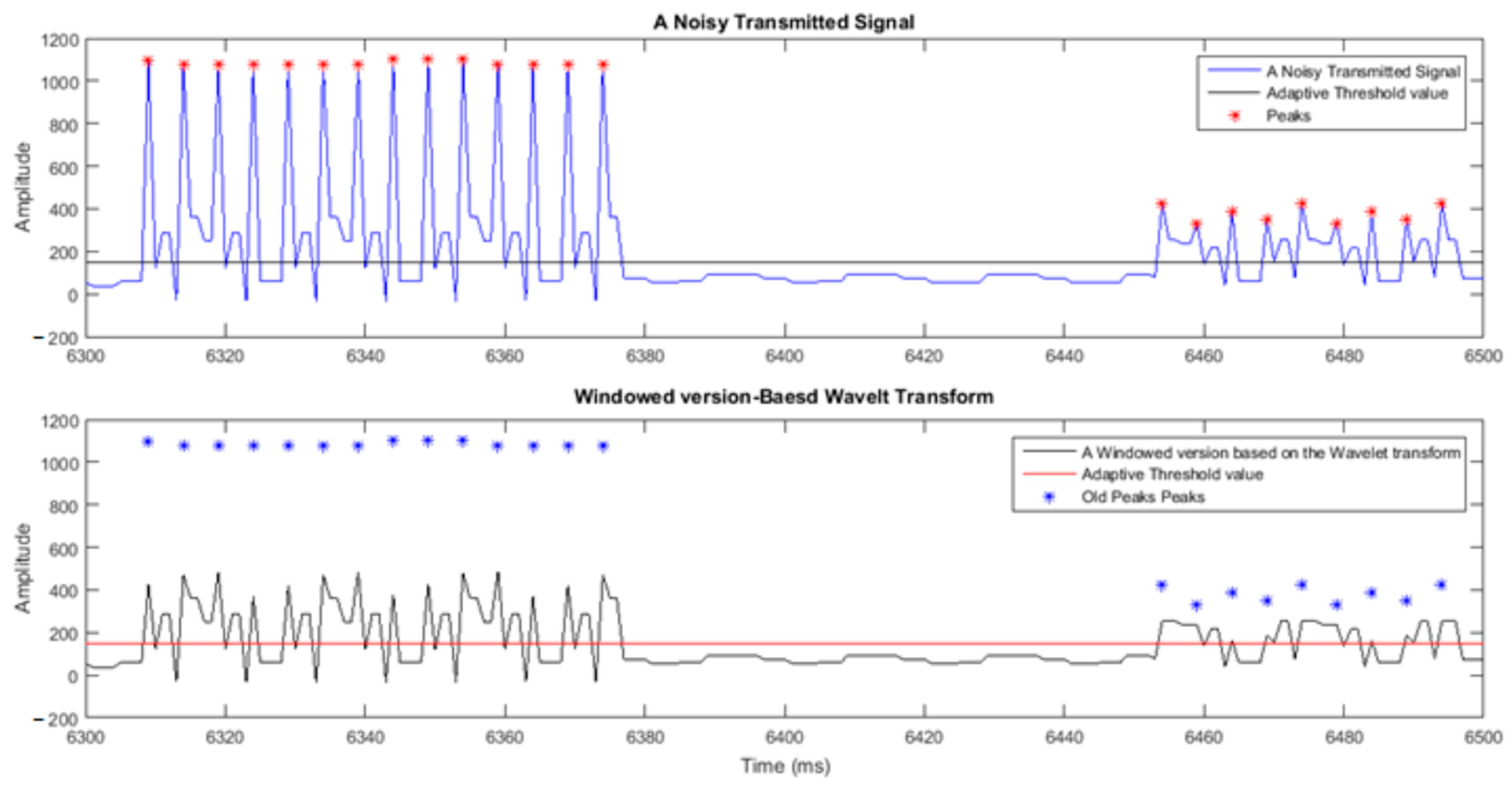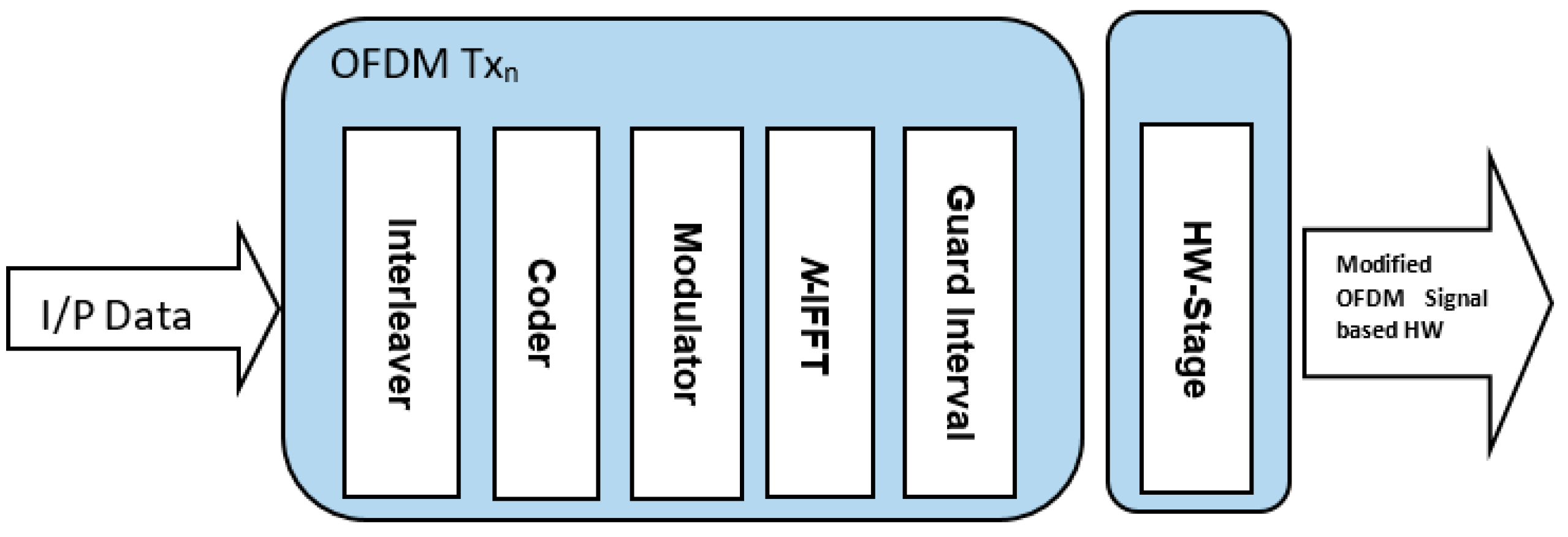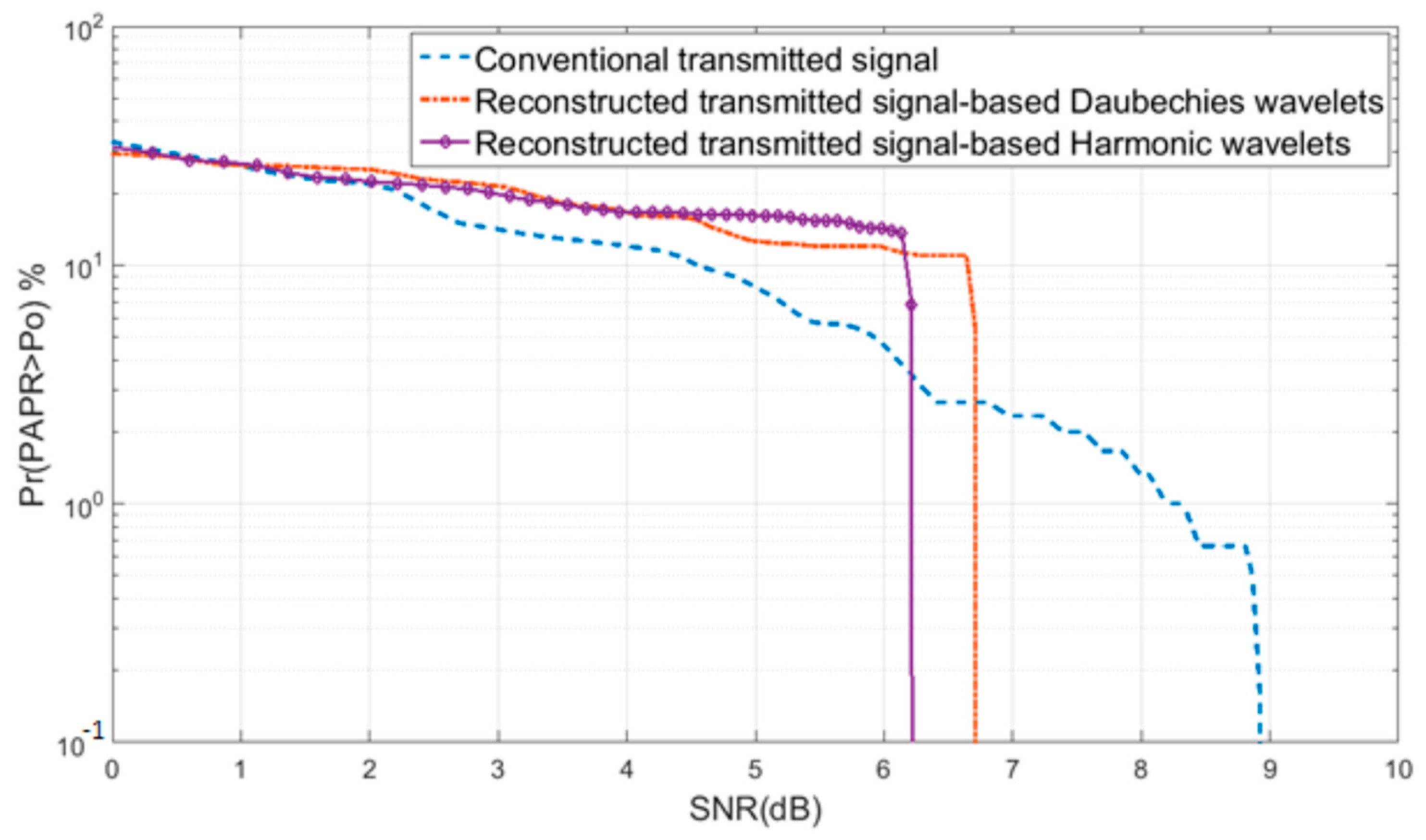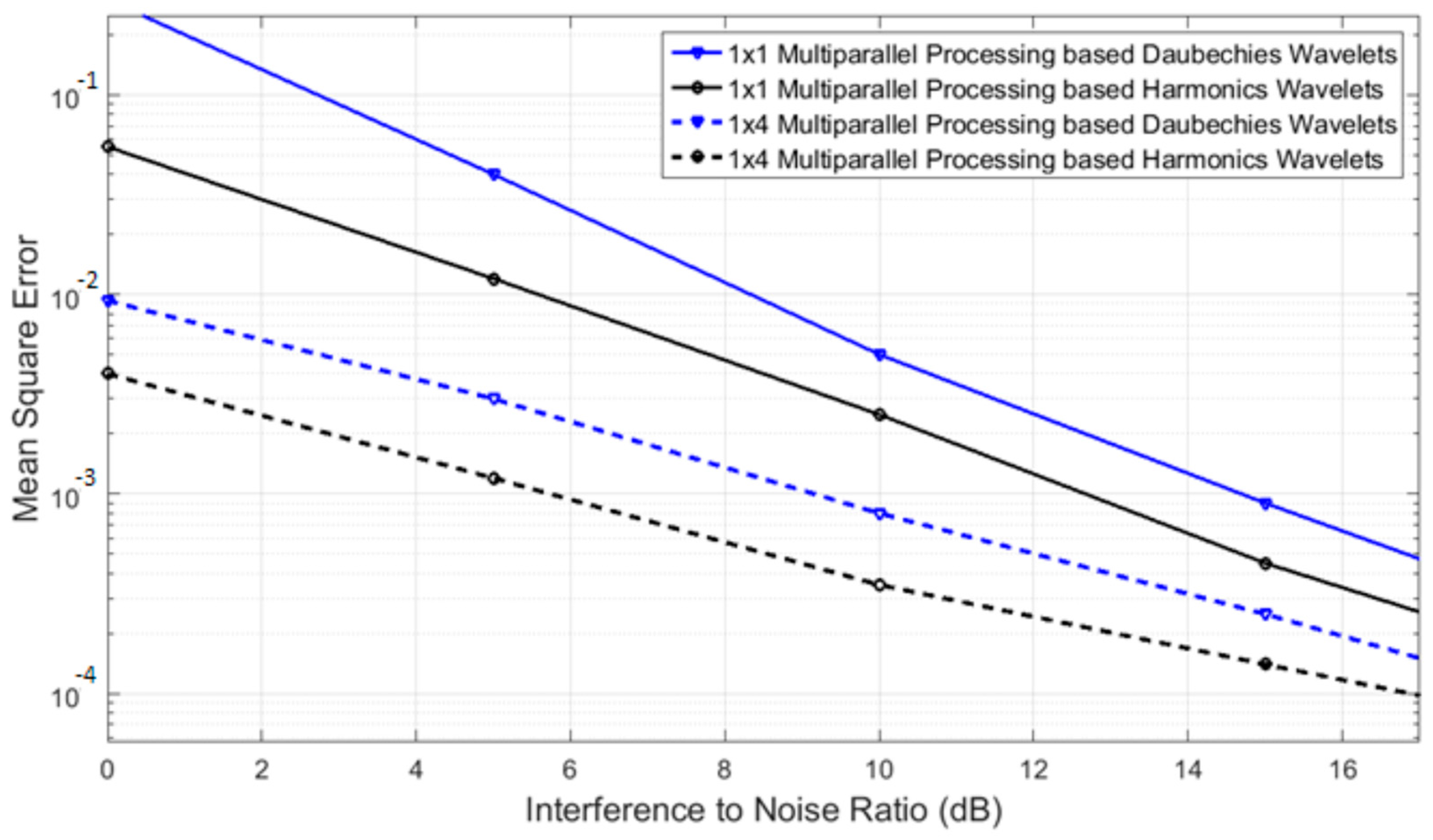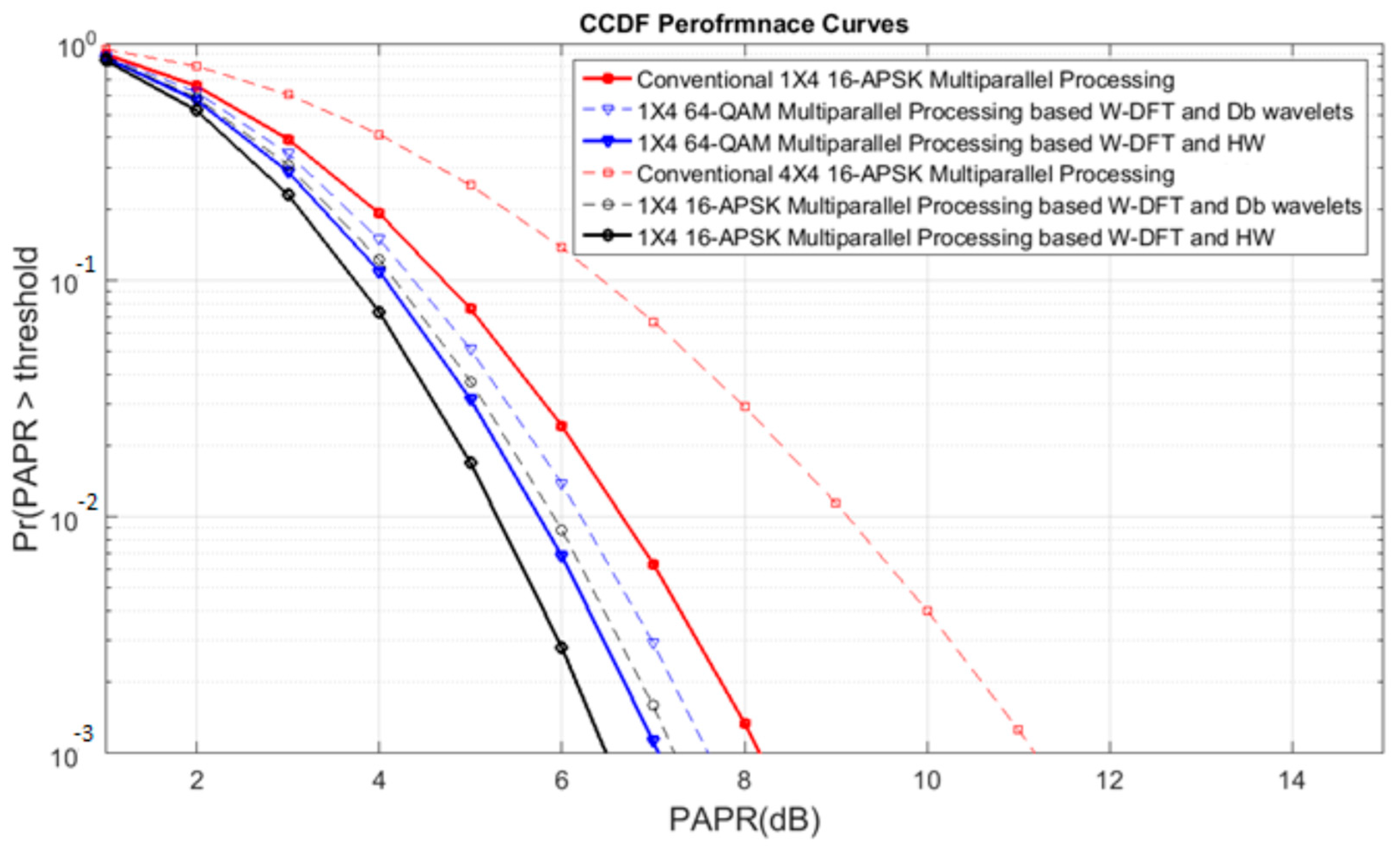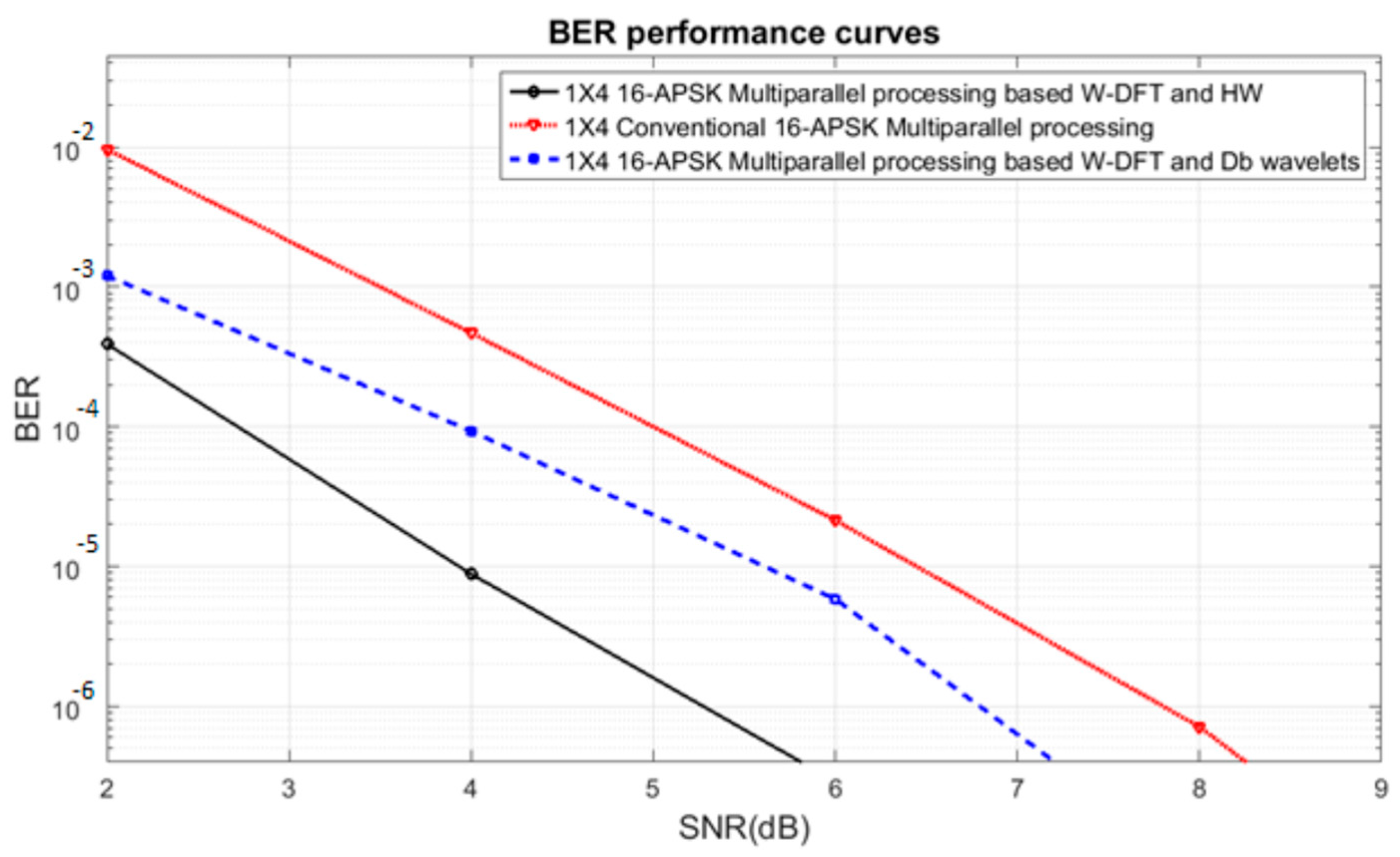1. Introduction
The improvement of the wireless communications market during the last decade shows that billions of smart, Internet-of-Things (IoT)-based devices are available in the market. These are in needs of special treatment from the connectivity point of view, especially for smartness scenarios from wearable devices towards smart cities. As a communication system, many performance parameters should be studied to check the system’s Quality of Service (QoS), such as the latency, system throughput, and communication range. Therefore, the Narrowband Internet of Things (NB-IoT) standard has been proposed by the Third-Generation Partnership Project (3GPP) to optimize the smart system’s connectivity. This standard has a 200 kHz bandwidth to be merged easily with the recent communication systems [
1,
2,
3,
4,
5,
6,
7].
Vehicle-to-Vehicle (V2V) communications, as part of intelligent transportation systems, have gained great attention through the development of wireless communication networks. It has been standardized through both the Vehicular Ad-hoc Network (VANET) and the IEEE802.11p standard. The V2V technology can be imposed on the regular wireless communication infrastructure, however, this coexistence is attained under the penalty of a significant increase in the latency factor. This drawback could be mitigated under the complexity factor using the Device-to-Device (D2D). This kind of merging (VANET and Long-Term Evolution (LTE) standards) has been investigated in the literature to enhance the QoS for communication links, i.e., the verified Dedicated Short-Range Communication (DSRC) technique, which can test the latency issue in the communications benchmark between the V2V and LTE systems. The DSRC has been studied thoroughly and successfully implemented in the vehicle’s communications propositions. It has the advantage of collision avoidance and traffic information; therefore, it is easy to be implemented either in safety or non-safety applications. Furthermore, the link reliability was also investigated in many works based on the block error ratio and the signal-to-noise ratio values, such as the LTE4V2X and the sensing-based semi-persistent scheduling (SPS). SPS could realize the communication links among the vehicles without coordinating the existing infrastructure. They showed the powerfulness of the combined benchmark and its feasibility to be deployed in many applications. Although there are so many recommendations to be deployed in the recent technologies, there are some problems to be tackled. Including, the latency issue and the link efficiency [
8,
9,
10,
11,
12,
13,
14].
In the recent wireless technologies that use the IEEE802.11p standard, the Orthogonal Frequency Division Multiplexing (OFDM) technology is the solution to enhance the QoS based on mitigating the channel effects. Therefore, it is considered the dominant technology in recent years. One of these technologies is the NB-IoT which provides the spectrum-reuse ability and occupancy under the in-band mode. Accordingly, a huge number of nodes can be interconnected efficiently concerning the minimal bandwidth availability. OFDM offers the best usage of the limited bandwidth, especially under the overlapping occurrence. Therefore, the V2V physical layer and medium access control layer will be modified to enhance the QoS for such massive-machine connections based on the power consumption, data rate, and complexity factors. However, the constraints of using OFDM under mm Waves applications become stricter [
3,
4,
8,
15,
16,
17,
18,
19].
Two leading technologies were discussed for the low power wide area (LPWA), namely NB-IoT and the long-range (LoRa). In their work, a comprehensive survey has been conducted. As a result, they are considered efficient solutions for the VANET technologies, in terms of the cost, the capacity, and the lifetime of the batteries. Moreover, such solutions are reflected in the QoS issues, specifically the latency and communication reliability [
3,
4]. In [
8,
15] the V2V communications were overviewed for the LTE-vehicle (LTE-V) standard, which supports the sidelink. They introduced the needed changes for Releases 14 and 15 physical layers to support the fifth generation (5G). These modifications were introduced to enhance vehicle-to-everything (V2X) communications in addition to autonomous vehicles. Therefore, two different modes, namely Mode 3 and Mode 4, were discussed extensively. They showed the performances for these two modes either in supporting the V2V communication or in representing alternatives to the IEEE802.11p or the DSRC. Accordingly, a room of investigation is opened.
In this work, to enhance the VANET QoS from the reachability point of view, a Multi-Input Multi-Output (MIMO)-OFDM-based benchmark has been proposed to be compatible with LTE infrastructure. Although this combination is preferable to maximize the system’s throughput and robustness against the channel effects, it also burdens an extra load on the system’s QoS from the delay point of view. Accordingly, the relationship between the mobility factor and the QoS must be studied and investigated [
20]. Therefore, this benchmark is proposed to include a new reclustering technology and the multiparallel processing technique with a special type of antenna deployment. Based on a such proposition, the physical layer is modified to include the needed modifications.
The contribution of this work falls in enhancing the QoS of vehicular communications from both the latency and the complexity point of view. Therefore, and according to fulfill such contribution, the following studies are needed:
The latency issues have been investigated based on the causes of different types of collisions [
20,
21].
The effect of the harmonics retrieval and the frequency leakage has been thoroughly studied [
22].
Accordingly, this work proposes a V2V benchmark based on MIMO-OFDM that has a specific antenna deployment to overcome the self-interference. The transmission through such deployment will use the full-duplex concept. Furthermore, a modification has been made to the used OFDM stage to contain the windowed Discrete Fourier-Transform (W-DFT) to combat the leakage frequency main drawback; i.e., the system complexity.
This paper is organized as follows: the modified benchmark is detailed in
Section 2, the analysis and the simulation results are given in
Section 3, and
Section 4 details the conclusion.
2. Modified V2V Benchmark
This section will introduce the V2V benchmark based on LTE wireless infrastructure. It consists of a clustering topology that is used to enhance both the connectivity and the transmission data rate among the vehicles. Moreover, it covers the proposition of using the full-duplexing process and the MIMO deployment structure. Then, it describes the modification of the proposed benchmark based on the W-DFT process and the use of the Harmonic Wavelets (HW).
Figure 1 depicts the V2V benchmark for N-moving vehicles based on LTE structure. It is clearly shown that there are two scenarios: V2V communications-based Ad-Hoc and communications through the LTE infrastructure. In this benchmark, N vehicles communicate with each other under the IEEE802.11 p protocol through one node called cluster’s head (CH). Previously in our published work [
19], the performance of the communication’s link through CH has been studied based on two factors, namely power management, and link reliability. Accordingly, our new benchmark will be based on a pre-checked reclustering algorithm. This is clearly depicted in
Figure 1.
To fulfill the requirements of the benchmark in
Figure 1, both the physical layer and medium access control layers are modified to include the OFDM transceiver with 52 orthogonal subcarriers-inverse fast Fourier-transform (IFFT) stage, 2/3 convolutional encoder stage, and a 16-APSK modulation stage. In each transceiver, multiple antenna deployment is introduced to combat the radio channel effect. Each e-Node B (e-NB) in the LTE structure can realize the process of the communications among vehicles; the communicating process under the V2V system. In each moving node (vehicle), there will be one transmitting link and four receiving links. Therefore, the SPS technique can easily schedule this process without affecting the reliability of the communication links. It controls the whole process based on the persisting time, where the starting of a new process is assigned with a zero time [
8]. The vehicle’s size is a considerable factor that must be taken into consideration to maximize the benefits of the full-duplex scenario. Accordingly, the antennas can be easily accommodated in large vehicles’ bodies to fit the self-interference proposition compared to large-scale-propagated transmitted signals. Therefore, the used self-interference cancellation process implies the use of a full-duplexing utilization scenario. This scenario enhances the link reliability by efficient spectrum utilization and reducing the implementation complexity. Therefore, it is a possible candidate for use in narrowband communications [
21].
The antenna’s deployment is clearly depicted in
Figure 2. This deployment enhances the link reliability based on the spatial multiplexing MIMO technique. In this proposition, the uncorrelated receiving links have been attained by making use of the resultant phase differences between vehicles.
In this deployment shown in
Figure 2, another proposition should be considered; the channel must be modeled to fit the short-range communications. This proposition is made due to the dynamic vehicle’s positions. Accordingly, n-dimensional random Gaussian variables are used as four rows describing the receiving antennas and one column as one transmitting antenna. This channel is modeled based on the mmWaves model and considered as a uniform linear array as expressed mathematically in [
23] as:
In this expression, each specific path has a complex gain denoted by , the angles of arrivals and departures have been defined by and , respectively. A transposed conjugated mathematical process is defined as , the delay and the period of each path are given by and , respectively. Due to the property of inherent sparse for the mmWaves channel, the total number of the received links is limited to four.
The V2V benchmark for N moving vehicles based on LTE structure is proposed under the use of DSRC protocol, which is licensed to work in the 5.9 GHz band. The deployment of such MIMO configuration is depicted clearly in
Figure 3.
The channel matrix is derived based on the combining matrix;
to form the baseband channel as:
Therefore, the received signals through these communication links are defined in the following mathematical representation as shown in (3). In this equation, one transmitting antenna and four receiving antennas are allocated. Therefore, the receiving, transmitting, and noise vectors are defined as
,
, and
, respectively.
In order to attain the orthogonality and to mitigate the channel’s effect, the W-DFT is proposed. This proposition is in addition to append the channel matrix with zeros. Thus, the complexity issue is mitigated.
Figure 4 depicts the wavelet proposition to enhance the QoS of the V2V systems.
The results of applying the W-DFT compared to the conventional transmitted signal are depicted in
Figure 5. A clear 55% modification has been attained as a modification for the proposed W-DFT. Accordingly, the noisy signals have been modified significantly based on enhancing the side-lobes above the adaptive threshold. From the attained results, the W-DFT is a promising technique that could replace the IFFT easily with guaranteed modifications not only in terms of the power management but also in the aliasing error. Therefore, it modifies the estimation methods in the multipath fading channels.
Each transmitted OFDM signal value in the transmitted vector is expressed in the time-domain as:
where it consists of
N orthogonal subcarriers that are formed through an
N points IFFT. The original data is represented by
and the orthogonality is attained through the following exponential term
. In order to employ the wavelet criterion, the time-domain signal in (4) is written as [
24]:
In this equation, the decomposition levels are defined by , the wavelet scaling, and the wavelet functions are defined as (.), and , respectively. The stands for complex conjugation.
Figure 6 depicts the modification of the communication block diagram including the wavelet-stage modification.
The communication link modification is applied to each transmitted signal in
Figure 2. On the receiver side, the minimum mean square error (MMSE) equalization stage can be used after removing the guard interval. The imposed wavelet stage in
Figure 6 allows multi-parallel processing in the new MIMO deployment depicted in
Figure 2. In such multi-parallel processing, the following procedure is as follows:
Eight decomposition wavelet levels are used in processing the transmitted OFDM signal.
Based on distributed energy, the new signal is decomposed based on the wavelet’s parameters.
Three criteria are used to check the performance of the reconstructed signals namely:
- (a)
CMSE: the mean-squared error.
- (b)
CMcorr: the correlation matrix.
- (c)
CSoAD: the sum of the absolute difference.
Figure 7 depicts the decomposition performance enhancement based on the Complementary Cumulative Distribution Function (CCDF). CCDF is defined as the probability of the power in any OFDM symbol exceeding a certain threshold.
In this comparison, two different wavelet criteria have been used to check the decomposition criteria performance; the harmonics wavelets and Daubechies wavelets. The results are aligned with the achieved ones in [
24], which stated that the harmonic wavelets are the fastest wavelets, in addition to outperforming our previously published work in [
25], which is based on Daubechies wavelets. The results show that the peak-to-average power ratio has been reduced to 6.2 dB for the probability of 10%, in addition to reducing the SNR by a factor of 33% over the conventional OFDM work. As a result, it has been shown that significant performance improvement can be achieved with Daubechies wavelets in the V2V physical layer. This clearly supports the 5G and beyond technologies.
3. Simulation Results Performance
In this section, a detailed environment has been simulated to cover the proposed system’s performance. The NB-IoT simulated model is covered based on the work of [
7], where the channel model is used as a Typical Urban. Moreover, the architecture of VANET communications is described in [
14]. Accordingly, an extensive MATLAB simulation has been performed in order to validate the proposed work. It has been checked based on the latency, and interference elimination criteria. Therefore, the simulation parameters are limited to:
- -
MIMO system with one transmitting and four receiving antennas using the weighted averaging method;
- -
The receiver equalizer is limited to the MMSE at a Doppler shift of 300 Hz;
- -
OFDM signal with 600 points and a 0.25 guard interval;
- -
A 15 kHz as orthogonal carrier’s spacing frequency;
- -
Six taps ITU-R channel with a delay spread of 2.51 µs;
- -
2/3 convolutional encoder;
- -
Modulation techniques including 64QAM and 16-APSK;
- -
The channel bandwidth of 200 kHz based on the NB-IoT scenario;
- -
The vehicle’s speed range of 20 km/h-to-70 km/h;
- -
Transmission range of 15 m.
The following
Table 1,
Table 2 and
Table 3 summarize the system performance of five randomly chosen signals based on the three decomposition performance factors, namely C
MSE, C
Mcorr, and C
SoAD.
It is clearly shown that the harmonic wavelet is faster than the Daubechies. From all these results the harmonics wavelet reaches the same CMSE value at a faster decomposition level; it achieves the same value with a percentage of 33.1% faster than the previously published work in [
25].
Table 2 depicts the reconstruction performance based on the Correlation matrix criterion. Here, the reconstruction speed is still faster than the conventional work, however, it is somehow slower than the achieved results of using the CMSE evaluation criterion.
Table 3 depicts the results of the proposed work based on the Sum of the Absolute Difference criterion. Again, the harmonics are still faster than the Daubechies. However, it is the fastest among the three performance criteria. It reaches up to 62.5% reconstruction enhancement based on the speed point of view. Accordingly, and as a drawn result, the harmonics wavelet gives better reconstruction performance compared to the use of Daubechies wavelets in [
25].
In order to check the proposed work performance from the MSE and the signal-to-noise ratio,
Figure 8 depicts the results of two MIMO deployment scenarios;
, and
with a self-interference cancellation proposition as depicted in
Figure 2.
It is drawn from the results an enhancement of 33.3% for the MSE curves; it reaches the 6 dB interference to noise ratio at an MSE of
. This achievement is in addition to a 60% enhancement over the SISO scenario. Furthermore, the achieved results outperform the work in the literature [
25]. Accordingly, multiparallel processing will be considered a promising technique, which will be adopted in the recent V2V technologies especially under the channel’s challenges for the huge number of moving vehicles.
From the CCDF point of view,
Figure 9 depicts the comparison results of the probability that exceeds a certain threshold. In these curves, a comparison has been made from two different points of view; a number of antennas and modulation techniques. Again, from the depicted results, the use of harmonics wavelets outperforms the use of Daubechies with a percentage of 49% extra peak power reduction compared to the work in [
25]. From the antenna’s deployment point of view, using the self-interference cancellation shows an extra 23.5% peak-to-power ratio enhancement. Using the 16-APSK shows a promising result that is aligned with the attained one in [
26], where it shows that the use of 16-APSK outperforms the use of the 64-QAM modulation technique. As a result, it has been shown that significant performance improvement can be achieved with Daubechies wavelets in the V2V physical layer. This clearly supports the 5G and beyond technologies.
Figure 10 depicts the results of the performance comparison from the BER point of view. From the results, the proposed work elucidates another enhancement compared to the work in [
25]. At an SNR of 6dB, the BER is almost
. Accordingly, the communication link has been improved by a ratio of 31% compared to the literature work [
25,
26]. As seen in
Figure 10, the conventional work result represents the demodulation process without the need for the ISI cancellation stage and no multiparallel processing. The other two curves were attained after imposing the proposed benchmark based on multiparallel processing with two approaches; namely the HW and the Daubechies wavelets. It is clear from the depicted results that the multiparallel processing stage can provide a significant improvement in the BER. Comparing these curves, it can be determined that the modified work based on the proposed reduces the time of processing. Consequently, the associated complexity of the modified physical layer is reduced.
The achieved result in the previous figures shows the powerfulness of the proposed work in terms of throughput, latency, and power management.
4. Conclusions
A proposition of a wavelet framework for a V2V system has been studied under the co-existence with LTE infrastructure. Three main performance parameters have been studied to enhance the VANET work structure, namely latency, harmonics retrieval, and the PAPR problem.
Therefore, studying the base station’s latency issue and proposing a solution, different types of collisions and their causes were investigated. The VANET performance has been studied based on reducing the base station’s latency. As a result, the full-duplex concept was chosen to reduce both interference of multi-users and the half-duplex miss reception. Therefore, the antenna deployment has been investigated concerning self-interference cancellation. Accordingly, a remarkably high spectrum efficiency is achieved. The harmonics retrieval issue has been studied; the windowed Discrete Fourier-Transform (W-DFT) is proposed accordingly to tackle the complexity issues. Consequently, the W-DFT is imposed on the proposed benchmark to overcome the main drawback of the leakage frequency. The V2V system-based multi-parallel processing quality has been studied based on the proposed method of W-DFT, which outperforms the work in the literature. Using the W-DFT, an extra 55% noise reduction has been attained. Accordingly, the noisy signals have been modified significantly based on enhancing the side-lobes above the adaptive threshold. Thus, W-DFT is a promising technique that could replace the IFFT easily with guaranteed modifications not only in terms of the power management but also in the aliasing error. Therefore, it modifies the estimation methods in the multipath fading channels. As a result, it has been shown that significant performance improvement can be achieved with Daubechies wavelets in the V2V physical layer, where a 33% extra reduction has been attained from the CCDF point of view. This clearly supports the 5G and beyond technologies.
The achieved result shows the powerfulness of the proposed in terms of throughput, latency, and power management. From the CCDF point of view, the use of harmonics wavelets outperforms the use of Daubechies with a percentage of 49% extra peak power reduction compared to the work in the literature. From the antenna’s deployment point of view, using the self-interference cancellation shows an extra 23.5% peak-to-power ratio enhancement. The use of 16-APSK outperforms the use of the 64-QAM modulation technique. From the BER point of view, at an SNR of 6dB, the BER is almost . Accordingly, the communication link has been improved by a ratio of 31%.




